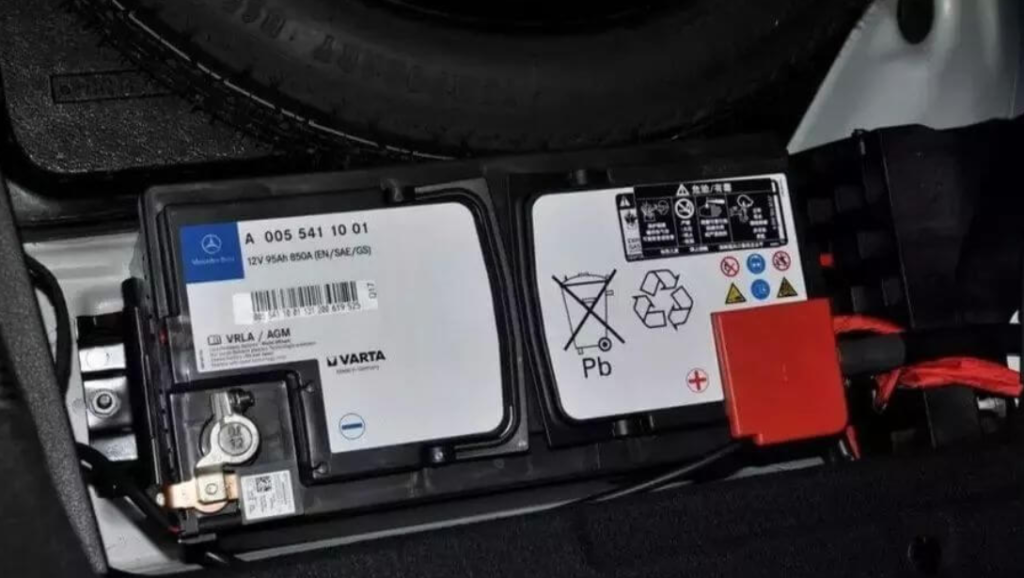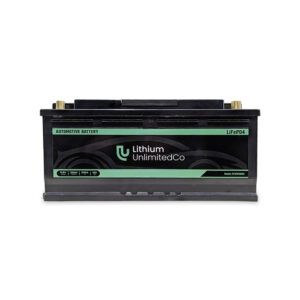NEWS & Blogs

Why Choose LFP Over AGM for Safety? How and Why
Understanding LFP and AGM Batteries
What Are LFP Batteries?
Lithium Iron Phosphate (LFP) batteries, a type of lithium ion vehicle battery, use lithium iron phosphate as the cathode material. These batteries are known for their exceptional thermal stability, long cycle life, and robust safety features. They are widely used in applications such as electric vehicles, renewable energy storage systems, and other critical energy storage solutions. Companies like Lithium UnlimitedCo are leading the way in providing advanced LFP battery technologies that promise enhanced safety and efficiency.
What Are AGM Batteries?
Absorbent Glass Mat (AGM) batteries are a type of lead-acid battery that uses a fiberglass mat to absorb the electrolyte. This design makes them spill-proof and maintenance-free. AGM batteries are commonly used in automotive, marine, and backup power applications due to their reliability and relatively low cost.
Environmental Impact: LFP vs. AGM
Lead Mining and Processing
AGM Batteries: The production of AGM batteries involves significant environmental concerns. Lead mining and processing result in substantial environmental impacts, including air and water pollution. The sulfuric acid electrolyte used in these batteries is hazardous and requires careful handling and disposal to avoid environmental contamination. Improper disposal can lead to lead leaching into soil and water, posing long-term environmental and health risks.
LFP Batteries: While LFP batteries avoid the issues associated with lead, their production is not without environmental consequences. The mining of lithium and other materials can result in significant ecological disruption. Moreover, the manufacturing processes for LFP batteries are energy-intensive. However, compared to AGM batteries, LFP batteries have a lower environmental footprint due to their longer lifespan and potential for reuse. Responsible sourcing of materials and advances in recycling technologies are crucial to minimize the environmental impact of LFP batteries.
Use and Disposal
AGM Batteries: AGM batteries typically have a shorter lifespan compared to LFP batteries, necessitating more frequent replacements and disposal. While the recycling infrastructure for lead-acid batteries is well-established, the process is energy-intensive and can still result in environmental pollution. Improper disposal of AGM batteries can lead to lead contamination, further exacerbating environmental concerns.
LFP Batteries: LFP batteries boast a longer lifespan, reducing the need for frequent replacements and thereby minimizing environmental impact. The recycling of LFP batteries is an emerging industry, but it is not as widespread as the recycling of lead-acid batteries. Nonetheless, improper disposal of LFP batteries can still be harmful due to the presence of heavy metals and electrolytes. Despite these challenges, LFP batteries offer a potentially greener alternative, especially when combined with responsible recycling practices.
Safety Features: LFP vs. AGM
LFP Batteries: LFP batteries are known for their chemical stability. The use of iron phosphate in the cathode provides a stable framework that resists decomposition, even under high temperatures. This stability greatly reduces the risk of thermal runaway, a dangerous condition where the battery can overheat and potentially catch fire or explode. The inherent chemical properties of LFP batteries make them a safer choice for various applications, including the increasingly popular lithium-ion vehicle batteries.
AGM Batteries: AGM batteries, while stable under normal conditions, are susceptible to issues like gas buildup if overcharged. The absorbed electrolyte design helps prevent spills and leaks, which reduces the risk of short circuits and corrosion. However, the potential for hydrogen gas production during overcharging presents a risk of explosion if not adequately managed.
Thermal Management
LFP Batteries: LFP batteries excel in thermal management. They can operate safely over a wide temperature range and are less prone to overheating compared to other types of lithium-ion batteries. This makes them ideal for use in environments with fluctuating temperatures, as they do not require extensive cooling systems. The lower thermal sensitivity of LFP batteries contributes to their safety, making them a preferred choice for applications like electric vehicles and renewable energy storage.
AGM Batteries: While AGM batteries are also designed to handle a range of temperatures, they are more sensitive to high temperatures than LFP batteries. High temperatures can accelerate the aging process and lead to reduced capacity or even thermal runaway in severe cases. Proper ventilation and temperature control are essential to maintain the safety and performance of AGM batteries.
Overcharge and Over Discharge Protection
LFP Batteries: LFP batteries are inherently safer when it comes to overcharge and over discharge protection. They have a flatter voltage curve, which prevents sudden drops or spikes in voltage that could lead to unsafe conditions. Advanced Battery Management Systems (BMS) are often integrated with LFP batteries to monitor and regulate charging and discharging, further enhancing safety. These systems help ensure that LFP batteries are charged and discharged within safe limits, preventing potential safety hazards.
AGM Batteries: AGM batteries have built-in safety features like pressure relief valves to prevent overcharging. However, overcharging can still lead to the buildup of hydrogen gas, posing a risk if not properly vented. Over Discharging an AGM battery can cause sulfation, a condition where lead sulfate crystals form on the battery’s plates, leading to reduced capacity and potential battery failure. While these issues are generally manageable, they require careful monitoring and maintenance to ensure safety.
Energy Efficiency and Performance
Energy Conversion Efficiency
AGM Batteries: AGM batteries are less efficient in terms of energy conversion compared to LFP batteries. They lose more energy during charge and discharge cycles, which translates to lower overall efficiency. This inefficiency means that more energy is required to charge the battery, and less usable energy is available during discharge.
LFP Batteries: LFP batteries are more energy-efficient, providing greater usable capacity from the stored energy. Their higher energy conversion efficiency means that less energy is wasted during charge and discharge cycles. This efficiency not only makes LFP batteries a more sustainable option but also reduces the operational costs associated with energy storage.
Lifespan and Reliability
AGM Batteries: AGM batteries typically have a shorter lifespan compared to LFP batteries. They are designed for applications that require moderate cycle life and are often replaced more frequently. While AGM batteries are reliable for short-term use, their shorter lifespan can result in higher long-term costs and increased environmental impact due to more frequent replacements and disposal.
LFP Batteries: LFP batteries have a significantly longer lifespan, often lasting two to three times longer than AGM batteries. This extended lifespan reduces the need for frequent replacements, leading to lower long-term costs and reduced environmental impact. The reliability and durability of LFP batteries make them an excellent choice for long-term applications, such as renewable energy storage and electric vehicles.
Economic and Practical Considerations
Cost and Availability
AGM Batteries: AGM batteries are generally more affordable upfront compared to LFP batteries. Their established production processes and widespread availability make them a practical choice for many applications, particularly where budget constraints are a concern. However, their shorter lifespan and lower energy efficiency can lead to higher overall costs over time.
LFP Batteries: LFP batteries typically have a higher initial cost compared to AGM batteries. However, their longer lifespan, higher energy efficiency, and lower maintenance requirements can result in lower total cost of ownership. As the demand for sustainable and safe energy storage solutions grows, the cost of LFP batteries is expected to decrease, making them more accessible and cost-effective.
Specific Applications
AGM Batteries: AGM batteries are well-suited for applications that require a reliable power source with moderate cycle life, such as automotive, marine, and backup power systems. Their spill-proof design and low maintenance requirements make them a practical choice for these applications. However, for long-term energy storage and high-cycle applications, AGM batteries may not be the most sustainable option.
LFP Batteries: LFP batteries are ideal for applications that demand high safety, long lifespan, and high energy efficiency. They are particularly well-suited for electric vehicles, renewable energy storage, and other long-term energy storage solutions. Companies like Lithium UnlimitedCo are at the forefront of developing advanced LFP battery technologies that meet the growing demand for safe and sustainable energy storage.
Recycling and End-of-Life Considerations
AGM Batteries
AGM batteries have a well-established recycling infrastructure, which helps mitigate some of the environmental impacts associated with their disposal. However, the recycling process for lead-acid batteries is energy-intensive and can still result in environmental pollution. Improper disposal of AGM batteries can lead to lead contamination in soil and water, posing long-term environmental and health risks. It is crucial to ensure that AGM batteries are recycled responsibly to minimize their environmental impact.
LFP Batteries
The recycling of LFP batteries is a growing industry, but it is not yet as widespread as lead-acid battery recycling. Advances in recycling technologies and the development of new processes are helping to address these challenges. The longer lifespan of LFP batteries reduces the frequency of replacements, thereby minimizing the environmental impact associated with battery disposal. However, it is essential to ensure that LFP batteries are recycled responsibly to prevent potential environmental contamination from heavy metals and electrolytes.
Conclusion: Why Choose LFP Over AGM for Safety?
In conclusion, choosing LFP batteries over AGM batteries for safety is supported by a range of compelling factors. LFP batteries offer superior chemical stability, thermal management, and energy efficiency, making them a safer choice for various applications. While both types of batteries have environmental impacts associated with their production and disposal, LFP batteries have a lower overall footprint due to their longer lifespan and higher energy efficiency.
The decision to opt for LFP batteries over AGM batteries is not only about safety but also about making a more sustainable and cost-effective choice. Whether for electric vehicles, renewable energy storage, or other critical energy storage needs, LFP batteries provide a robust and future-proof solution.
As technology continues to evolve and the demand for safe and sustainable energy storage grows, LFP batteries are likely to play an increasingly important role in meeting these needs. By choosing LFP batteries, you are not only prioritizing safety but also contributing to a greener and more sustainable future. Companies like Lithium UnlimitedCo are at the forefront of this transition, offering innovative solutions that promise enhanced safety and performance for a wide range of applications.
Recent Posts
-
The Ultimate Guide to Choosing Lithium Batteries for Your Electric Vehicle
-
From Zero to Hero: The Impact of Lithium Powersports Batteries on Performance
-
Wake Up to the Power of Lithium: Transform Your Boat's Performance Today
-
Why Choose LFP Over AGM for Safety? How and Why
-
Why Lithium Golf Cart Batteries are a Game Changer for Sports Enthusiasts

